The Ultimate Beginner’s Guide to Avalanche
Avalanche is one of the most exciting blockchain technologies available today. It is fast, cheap to transact and the perfect entry point for those new to crypto or DeFi to start experimentation and grow their crypto portfolio.
Though Avalanche (AVAX) is only about a year and half old as of January 2022, the ecosystem has exploded in popularity in both users and developers since its start. As a result, there are currently several hundred active projects, making the beginner friendly blockchain a little daunting to navigate.
This guide will attempt to dissect all the essential things to do in AVAX ecosystem.
Table of Contents
- Setting up your wallet
- How to get $AVAX
- Staking
- Liquidity Mining and Yield Farming
- Lending and Borrowing
- Stables
- NFTs
- GameFi
- Building Dapps
- Helpful Tools and Resources

I. Setting Up A Non-Custodial Wallet
The first step in your crypto (also known as Web3) journey is to create a non-custodial wallet. You can think of a non-custodial wallet as a bank account you own. In DeFi, you hold the keys to your assets.
When you enter this world, you leave behind large banking institutions holding onto your assets. Your wallet is the key to everything you will be doing on Avalanche and DeFi in general.
DeFi vs Web3 vs Crypto
Before going further, some important definitions to consider:
DeFi: Decentralized finance (DeFi) is an emerging financial technology based on secure distributed ledgers similar to those used by cryptocurrencies. The system removes the control banks and institutions have on money, financial products, and financial services.
Web3: Web3 refers to a decentralized online ecosystem based on the blockchain. Platforms and apps built on Web3 won’t be owned by a central gatekeeper, but rather by users, who will earn their ownership stake by helping to develop and maintain those services.
Wallet Options
You will find several options when it comes to choosing your non-custodial wallet. The most popular of these is called Metamask.
Here are the steps to get you going on Metamask:
- Download Metamask
Head to metamask.io and look for the download button. It is currently available on Chrome, Firefox, Brave, Edge, iOS, and Android. Follow the steps to install.
2. Setting Up Metamask
Once installed, you can either import an existing wallet using your secret phrase/seed phrase or a JSON file, or create a new wallet and receive a secret phrase/seed phrase.
Remember to keep this phrase super safe. Some tips include writing it down somewhere you can not forget and treating it as if it belongs in a safe.
You will also be prompted to create a password- which is different from your secret phrase. Your password will allow you access to Metamask in your desktop browser or mobile app once you’ve logged in with your secret phrase once before.
Play around with the settings, seeking and adding your intended token and the network you downloaded Metamask for. You may have to add it via a custom RPC.
3. Configuring Avalanche on Metamask
Metamask by default is set to the Ethereum network. What that means is that anything on the Avalanche network will not be able to connect to your wallet. Configuring and then switching to the Avalanche network is easy however by following the steps laid out here.
Or, you can go to a Avalanche platform that will automatically configure the network for you. Lostworlds.io for example will automatically set it up for you when you connect.

The Avalanche Wallet
Avalanche itself has its own native wallet. Currently, the wallet is only supported on desktop browsers (mobile coming soon). The Avalanche wallet won’t be useful for most DeFi activities we will describe later on. The Avalanche Wallet is most useful for the following:
- Delegating or being a Validator of the network (these are for advanced users)
- Swapping between the X-Chain, C-Chain and P-Chain (more on these later)
If you would like to set up an Avalanche Wallet (and you should), simply go here: https://wallet.avax.network/ and follow the easy prompts.

II. How to Get $AVAX
The native token of Avalanche is $AVAX and will be the predominant token you use to transact on the network. It has become much easier since the autumn of 2021 to obtain Avalanche as it is now available for trading on most major exchanges.
Getting AVAX Method #1: Buying from an Exchange
An exchange, sometimes called a CEX (centralized exchange) is a similar to a brokerage that you buy normal stocks from.
The most well known examples are Coinbase, Binance, FTX and KuCoin. Both Coinbase and Binance provide you with a custodial wallet, meaning they control all the keys, but you still have access to all the assets in those wallets.
Step 1: To obtain AVAX, all you need to do is open an account on either those exchanges (or another that lists AVAX and gives you a custodial wallet).
Some exchanges like Voyager do not give you a wallet, thus you won’t be able to send your AVAX to your Metamask wallet. Some countries and localities may have some restrictions.

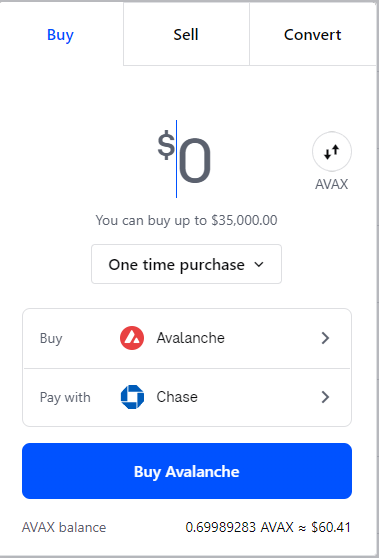
Step 2: Exchanging fiat for $AVAX.
After exchanging your $USD or other type of fiat for $AVAX, within a few minutes you should see you have the amount you exchanged in $AVAX in your account.
Step 3: Transferring from Exchange to Non-Custodial Wallet
The next step is getting your AVAX to your Metamask wallet from Coinbase or Binance. This part is easy but can also lead to costly mistakes if you are not careful.
Step 4: Make sure you are sending Avalanche

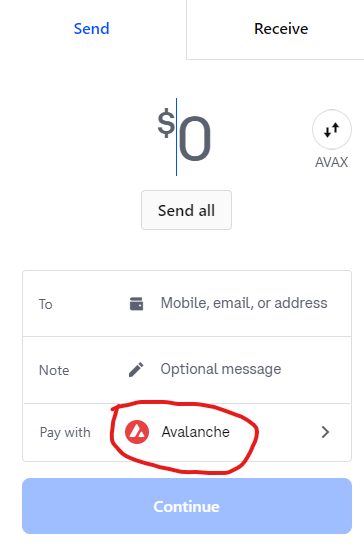
Step 5: Switch to Avalanche Network in Metamask
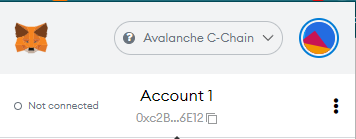
Step 6: Input your wallet address
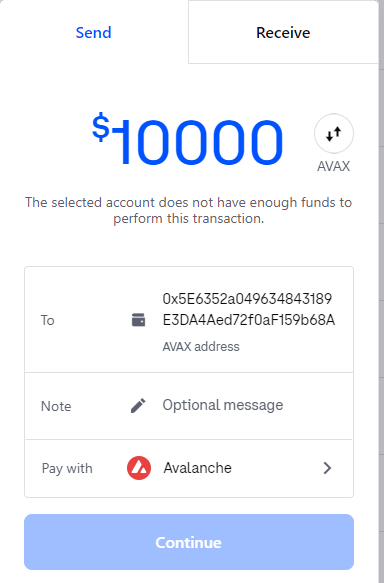
Avalanche is blazingly fast and you should see your AVAX in your Metamask within a few minutes or even a few seconds! Your AVAX will live on the C-Chain of Avalanche.
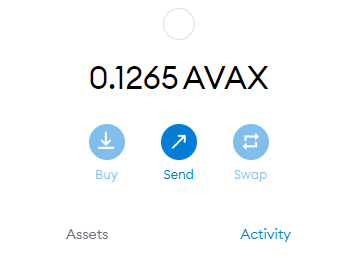
Explaining Avalanche’s P-Chain vs X-Chain vs C-Chain
Without getting too technical, Avalanche is a unique blockchain in that it has three “subchains” better known as “subnets”. Each subnet has its own purpose.
C-chain: the “contract” chain. This allows people to use AVAX and AVAX applications on the Ethereum Virtual Machine. All DEXs, NFTs, Games are built on the C-chain (for now at least)
X-chain: the “asset” chain. The X-chain creates the AVAX we use to transact.
P-Chain: the “governance chain”. The P-chain keeps the show running. It’s the chain validators are on, to ensure the entire Avalanche ecosystem is safe and secure.
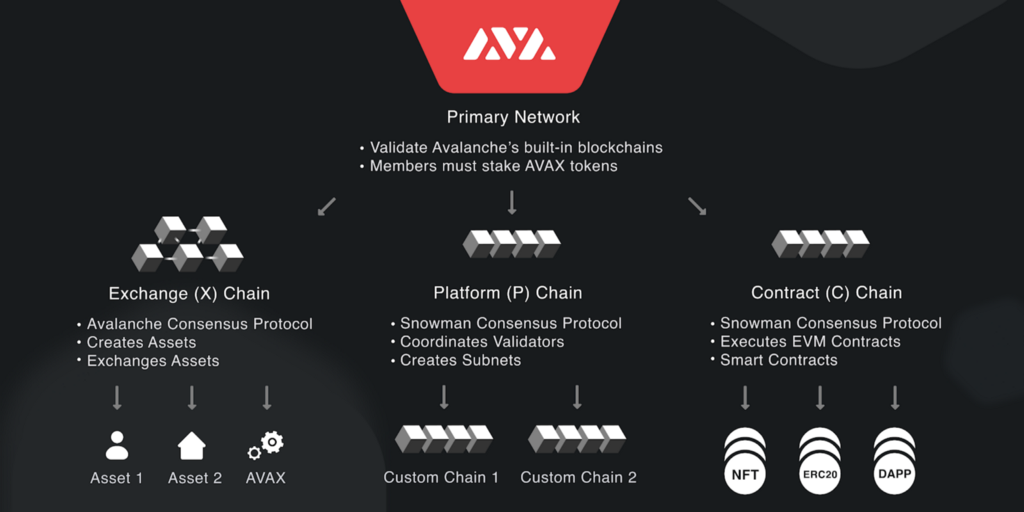
Getting AVAX Method #2. Bridging Over to AVAX
Another option you can explore is bridging (transferring) assets from another chain (i.e. Ethereum) over to Avalanche. Remember, Ethereum is a different blockchain than Avalanche.
So if you have Ethereum on the Ethereum network, you will not be able to use it on any Avalanche application. What you can do however is “bridge” your Ethereum to Avalanche and then swap your Ethereum (now called ETH.e) for AVAX. Here’s how to bridge:
- Go to https://bridge.avax.network/
- Select “Ethereum to Avalanche”
- Select the asset you want to bridge. It has to be Ethereum based but not necessarily Ethereum. For example, I can bridge USDT which is an ERC-20 (Ethereum) token
- Hit transfer.
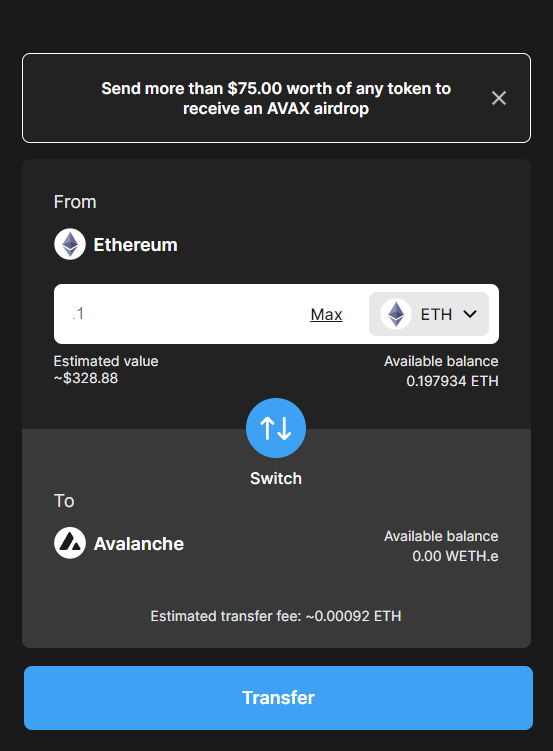
You will have to pay the Ethereum gas fee which is usually between $10 and $30 and then the Avalanche gas fee ( a few cents).
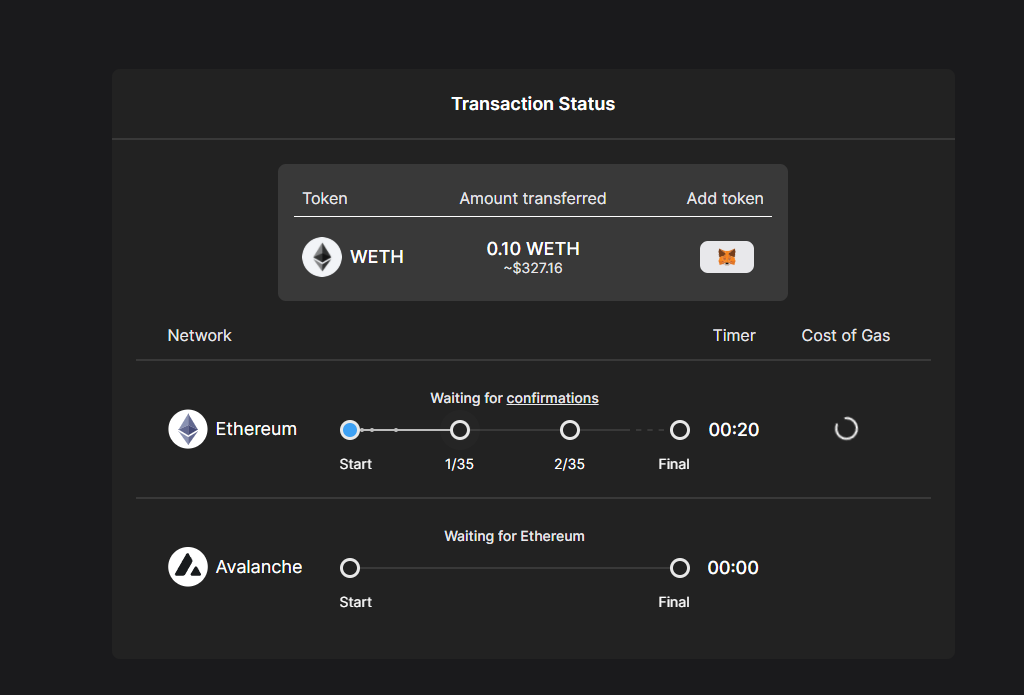
You’ll be able to watch the bridging happen. You’ll be able to compare the speed of Avalanche to Ethereum first hand. The Ethereum side of the transaction can take from a few minutes to a half hour depending on how buys the Ethereum network is.
When it is over, you will have WETH.e in your wallet. The symbol is different (it is technically Wrapped Ether) but the value is the same. To see it in Metamask you will need to add WETH.e to your Metamask/wallet. A tutorial is here.
What Do You Do with Your Avax?
Now that you have some AVAX in your wallet, you are officially ready to enter the world of DeFi, NFTs, GameFi and some many other exciting applications. We consider the following list to be the best things to currently do on Avalanche:
- Staking
- Liquidity Pools and Yield Farming
- Lending and Borrowing
- Using OHM Forks
- NFTs
- GameFi

1. Staking
What is Staking?
Staking means locking up your tokens so you cannot transfer or sell them. You may be asking, why would I do that? Well, for staking your AVAX, you are rewarded by the network in the form of more AVAX. For example, an Avalanche validator will earn an 11% APY on the amount of AVAX they stake. You can also stake on other platforms in the Avalanche ecosystem to also earn rewards.
Why Staking is Important on Avalanche?
On a network like Avalanche, staking is the fabric of how the technology operates. Avalanche uses a consensus mechanism called proof of stake.
Users called “validators” stake a certain amount of their $AVAX tokens to set up things called “nodes”. These nodes which exist around the world work to keep everything in order on the Avalanche blockchain.
Proof of Stake, solves some issues regarding speed and cost other blockchains like Ethereum and Bitcoin face. You can learn more about proof of work (how Ethereum and Bitcoin work) and how it compares to proof of stake here.
To learn how the Avalanche consensus mechanism works and what validators actually do, go here.
How to Stake on Avalanche?
There are several ways to stake on Avalanche. Some easier (and requiring less AVAX) than others.
- Being a Validator
As mentioned above, AVAX validators stake AVAX, run a node and keep the network flowing. Being a Validator is quite costly (2000 AVAX required) however and likely not the best idea if you are new to crypto and blockchain tech.
2. Being a Delegator
A delegator is similar to a Validator in that they are staking their AVAX to keep the blockchain secure and functional. The key difference is that they are giving (delegating) their AVAX to a Validator who is running a node. You only need 25 AVAX to be a delegator and can earn up to a 9% APY.
Both Validating and Delegating happen through the Avalanche Wallet (not Metamask) and requires you to swap your AVAX from the C-Chain to the P-Chain which can be done easily within the wallet.

3. Staking on a Lending Platform
If you are ok with a little more risk for a little higher reward, you can find lending and borrowing protocols built on Avalanche to stake your $AVAX. You simply deposit your AVAX through your Metamask account to the platform and you earn APY in the form that platform’s native token.
For example, one popular platform on Avalanche is called BenQi. You can go to BenQi, launch the app and connect your wallet to the platform. You should come to something that looks like this.
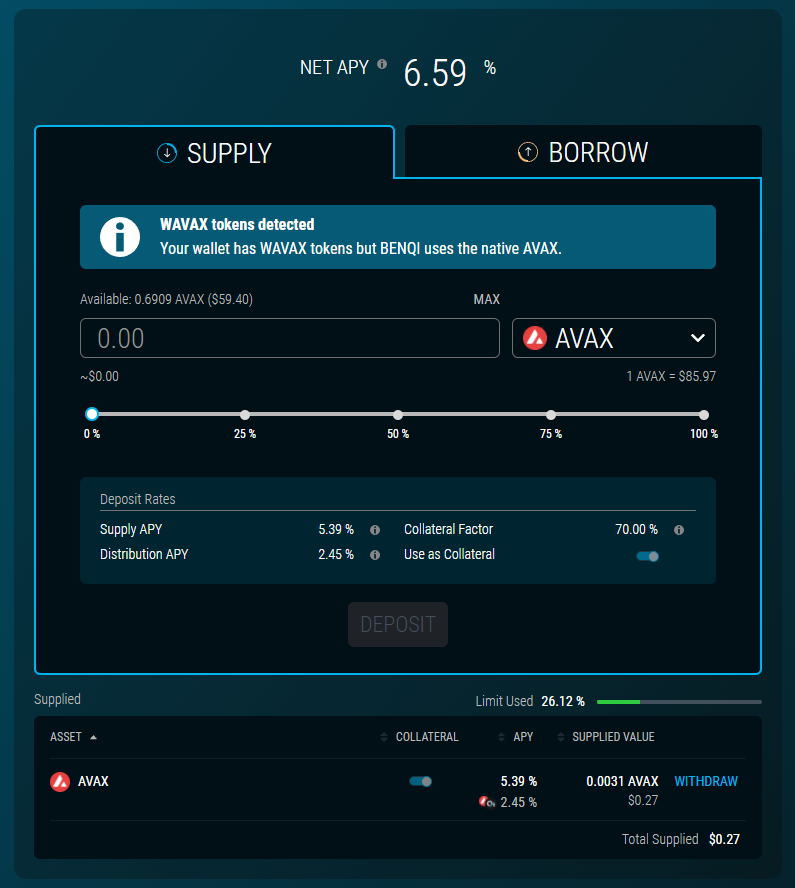
Make sure its set to “AVAX” and then use the slider to determine what percentage of your AVAX you want deposited. If you want the whole thing, then slide all the way to 100%. As you see, you will receive a net APY of 6.59% for staking on BenQi.
You can also deposit other tokens on BenQi to earn rewards such as USDC, USDT, DAI, etc.
Main Advantage of Staking on Platform vs Delegating/Validating
There are three main advantages to using a 3rd party platform to stake:
- Receive rewards in the native token: If you think a project is very sound and building toward something great, their token may rise in value meaning $100 in rewards from Platform A’s token can rise faster than the price of $AVAX, turning your $100 to something much greater.
- Higher APYs: sometimes you may find a platform can offer a more competitive APY than the delegation rewards
- Collateral borrowing: depositing your AVAX on BenQi allows you to take out a collateralized loan in another type of asset. We will talk more about the advantages of borrowing later on.
Staking on Avalaunch
Another staking option is on Avalaunch, a fundraising platform built on Avalanche. Avalaunch allows people to buy into a upcoming project’s token before the token is available for trading — this is called an Initial Dex Offering (IDO). Think of when a company IPOs and a series of insiders will get access to very cheap price of that stock. In DeFi, you are the insider and get to reap the advantage of getting a token so early on is that it will be at a very low price point.
All you need to do to get access to those tokens is by staking Avalaunch’s native token $XAVA on their platform.
For example, say you have project A with a token called $ABC and they are raising funds on Avalaunch. You can stake $XAVA on Avalaunch’s platform. This entitles you to a certain amount of $ABC in proportion to your staked $XAVA.
Disclaimer: if you reside in the U.S.A (and some other countries) you will not be eligible to stake XAVA in return for an IDO allocation (blame the SEC).

2. Liquidity Pools and Yield Farming
If it is high interest rates and rewards you are after, liquidity pools and yield farming is where you may want to look next. Liquidity pools and yield farming can offer APYs stemming anywhere from 20% to several thousand %.
What are Liquidity Pools?
Liquidity pools are the life blood of any DEX. Put simply, they are a crowdsourced aggregation of two cryptocurrencies. When you deposit your two tokens, they are locked up in the smart contract governing that pool and when someone uses a DEX to swap two currencies, the liquidity for that exchange is pulled from the pool.
Smart contracts, not bankers or book keepers, maintain the balance of the pools. Without liquidity pools, DEXs could not be run in a decentralized manner.
To incentive you to deposit liquidity into a pool, platforms also known as automated market makers (AMM) will give you a percentage of every transaction fee from that pool, proportional to your share of the pool.
How to Deposit Liquidity into a Pool
On Avalanche, the simplest way to start earning fees from a liquidity pool is to go to TraderJoexyz.com. Trader Joe (not the grocery store) is the largest and most popular decentralized exchange native to the Avalanche ecosystem.
Step 1: Determine the Pool
If you click into the “Pool” tab on Trader Joe, you will be taken to a list of the pools the platform offers. Some of these tokens may seem strange, but we’ll get more familiar with them later on.
As you can see, each pool has the total amount of liquidity currently in it, how active that pool is (volume & fees) and the APR (rewards) you get for participating in that pool.
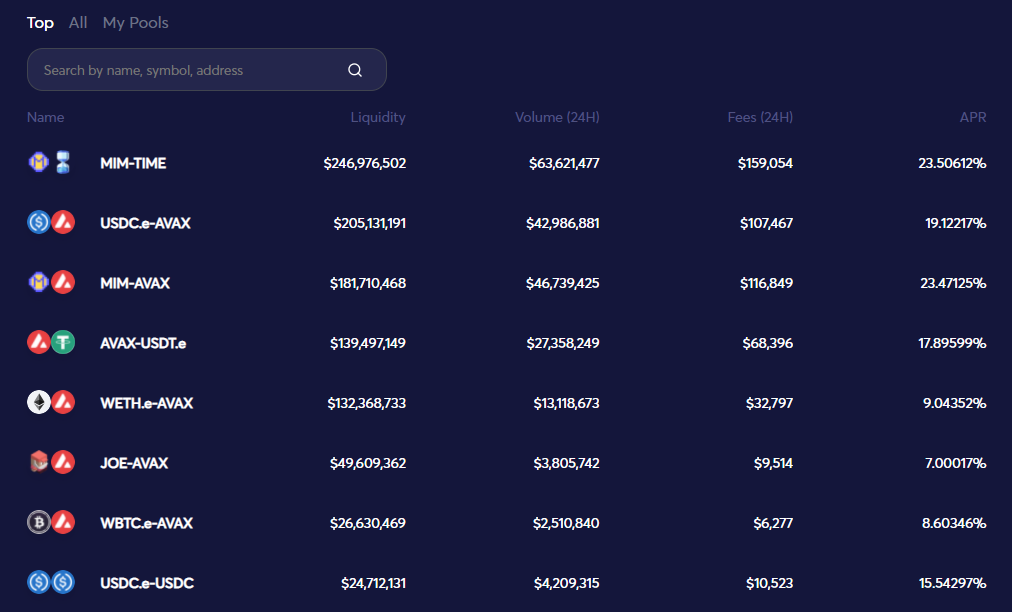
Optimizing for risk and rewards generally means 3 things:
- Finding a pool with a relatively high amount of liquidity (several million USD)
- Finding a pool with high APR
- Finding two tokens that will move in price together (to reduce impermanent loss)
For our example, let’s choose the $JOE-$AVAX pool
Impermanent Loss: when the price values of two tokens changes relative to when you 1st deposited the tokens. This can lead to losing out on the price increase of a certain token. Read more here.
Step 2: Obtain a 2nd token
Recall that a liquidity pool requires depositing two tokens in equal amounts to a pool. So if we want to participate in the JOE-AVAX pool, we’ll need an equal value amount of AVAX and equal value amount of JOE (the native token of Trader Joe)
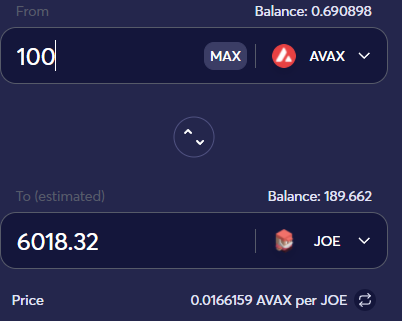
To get tokens you go to the “swap” part of Trader Joe. Remember you’ll need equal amounts. For example, if you have 300 AVAX in your wallet and want to contribute 100 AVAX to a pool, you will need to convert 100 AVAX to the equivalent amount of JOE. That will leave you with 200 AVAX and in this case, ~6,000 JOE.
Step 3: Contribute to the Pool
The next step is taking your ~6018 JOE and 100 AVAX and putting it in the pool. Go back to the “Pool” section and find the JOE-AVAX pool and click into it. You will find this interface:
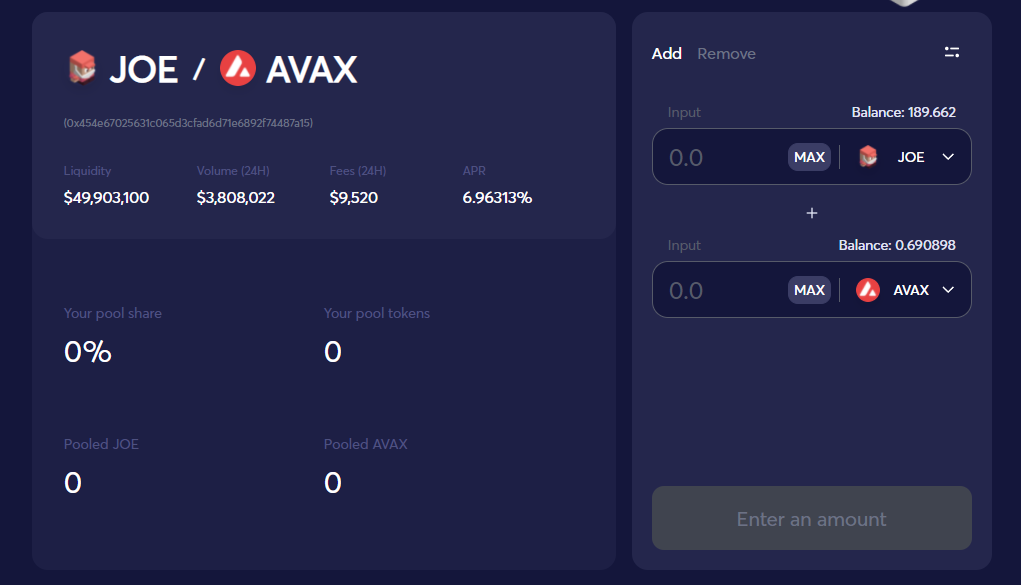
Simply input the amount of JOE and the amount of AVAX you want to deposit (in this case you can just select “MAX”).
You will have to approve the contract first. Then after approving the contract you can click the button again to actually contribute your liquidity to the pool.
Boom! You are now a liquidity provider on Trader Joe. Now you can get further rewards by yield farming.
What is Yield Farming?
Yield farming is lending your crypto assets in exchange for rewards. It is highly similar to depositing your fiat into a savings account and accruing interest. Except in this case, the rewards are going to be much higher than a typical savings account.
Another key difference with Yield Farming is the asset your are depositing. To yield farm you will need a liquidity token.
What is a Liquidity Token?
Imagine you are at a club and you check your coat at the door. You receive a ticket which entitles you to your jacket when you come to collect it. Liquidity tokens are similar in that they are your key to the liquidity you placed in the pool.
Remember, for a DEX to operate it needs liquidity of certain tokens to allow people to swap for that token. To incentive you to keep your liquidity in the pool, a DEX will give you even more rewards for locking up (staking) the token to that liquidity.
How to Yield Farm on Trader Joe
Sticking with our JOE-AVAX pool, after depositing our liquidity, we will receive a JOE-AVAX(WAVAX) LP token. Next you will want to go the the “Farm” tab. Similarly to the “Pool” page, you’ll see a list of farms that correspond to the pools that exist on Trader Joe.
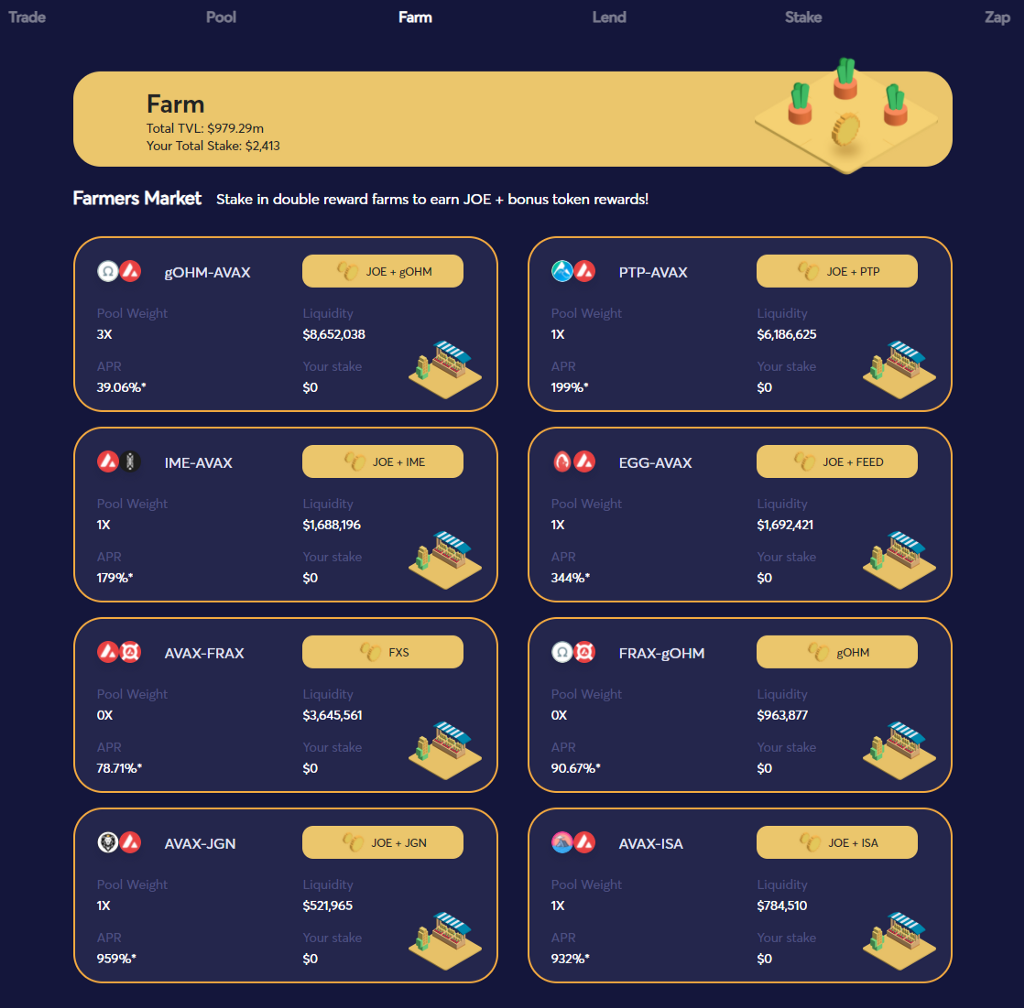
You’ll want to search for the JOE-AVAX farm and click into it. You’ll then find this interface:
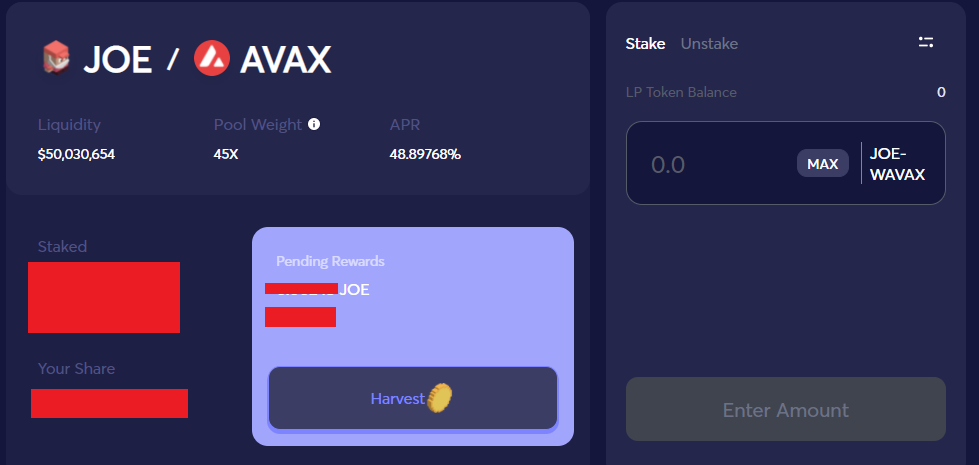
If you have let a few minutes pass between depositing your tokens in the liquidity pool, then you should see your available LP Token balance to be greater than 0. Hit the “MAX” button to deposit it all. Approve the contract and then click again to deposit your LP token.
If the APY is high enough, you can come back in a few days or even a few hours and see how much you have accrued in $JOE rewards. You can claim your JOE rewards at any time.
Compounding Rewards on Trader Joe and xJOE
Your journey for maximizing your rewards has one more potential step on Trader Joe. You can take the JOE you have earned through yield farming and stake it on Trader Joe to earn $xJOE.
xJoe is Trader Joe’s revenue sharing token. Revenue from the platform is collected to xJOE and used to buy back JOE tokens. Staking JOE entitles you to further rewards (generally b/w a 20 to 40% APR).
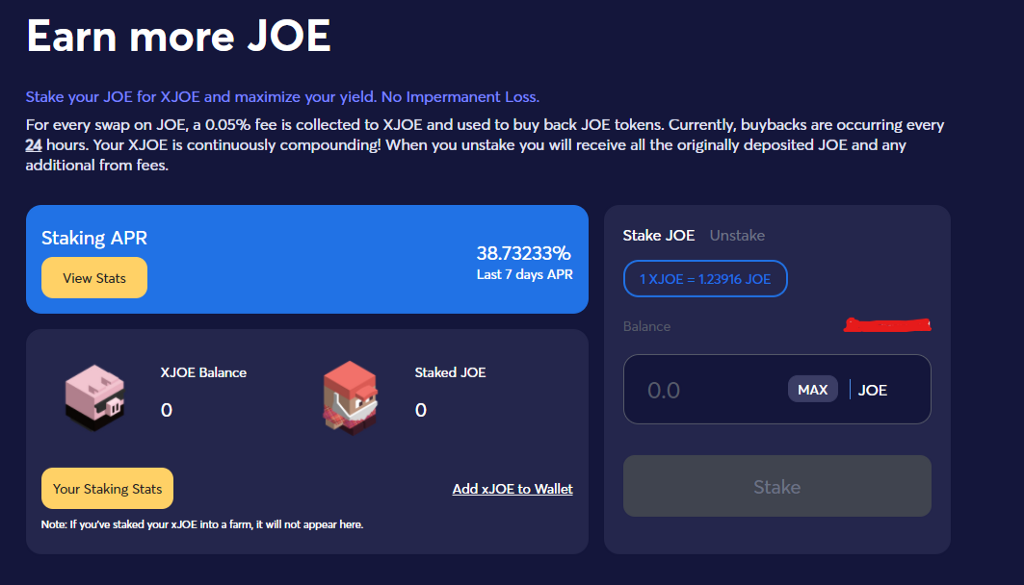
Then, you can go even further and stake your xJOE in the xJOE farm to earn even more rewards.
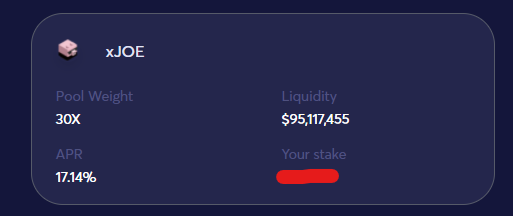
Other Platforms with Liquidity Pools and Yield Farming
TraderJoe is the most well known and largest DEX on Avalanche. There are other DEX’s and platforms on Avalanche where you can also put your tokens to work however. Sometimes one DEX will have exclusive access to a token you want or have special rewards for providing liquidity for a certain token. Those other DEXs include:
Rugpulls
There is something in crypto called a rugpull, which is when (usually) a new project forms, attracts a lot of capital and then takes off into the night with your liquidity and/or dumps their native token. Picture the image of someone swiping a rug from beneath your feet hence, rugpull.
How Do Rugpulls Work?
A example rugpull could look like “SCAM DEX” launches with liquidity pools or a single token staking pools with a super high APY (1000s of %). Then there is another pool with a super high APY to stake “SCAM Dex’s” token, $SCAM. You deposit $1,000 in AVAX into the platform and you soon find you have $100 worth of $SCAM in a day. Incredible!
You then stake your $SCAM to earn even more $SCAM. There’s a catch though, you have to wait at least 3 months to withdraw or sell your $SCAM or face a huge penalty.
The price of $SCAM skyrockets. People want $SCAM to stake and no one can sell $SCAM because it’s locked up for 3 months. In addition, the TVL (total value locked) on SCAM Dex also skyrockets so people can take advantage of the high rewards in the liquidity pools. Then, just as you are admiring your $SCAM rewards, the price tanks.
The devs of the projects may have dumped (sold) their allocation of $SCAM (their smart contract gave them an exception from the 3 month rule). Or maybe even more maliciously, they just ran away with the liquidity. No one ever hears from the $SCAM developers again and your $SCAM tokens are worthless.
How to Avoid a Rugpull?
Rugpulls still happen but as the community matures, they become harder to execute or they become more sophisticated. There are a few ways to identify a rugpull or to have a high suspicion a project is a rugpull:
- Are the devs “doxxed”: do the project developers have a public facing persona and/or better yet, is there verifiable information about them? If a developer is known, there is a less likely chance they will scam you (though this is by no means true 100% of the time)
- Look at the Smart Contract: The devil is in the smart contract. Are there suspect functions that give the devs special permissions, such as avoiding a lock up period? Auditing code does require some familiarity with Solidity however. Some projects will employ a 3rd party auditor to go through their contracts and deem whether they are safe or not. Look to see if a project has been audited by a reputable auditor.
- Gauging Public Sentiment: Explore Twitter and see what people are saying about a project. Some experienced or veteran traders will have a better eye for scams.
- Jump into the project Discord: every project has a Discord. Hop into the one you are wondering about and see how things are. Does the engagement seem artificial? Do devs interact with people in the community? A healthy project will have an organic Discord with devs actively engaging with members. Though again, this does not mean definitively the project is not a rugpull.
- Rugpull Watchdogs: Organizations like AVAX Rug Pull Prevention research different projects and call out suspected rugs
Should You Worry About Rugpulls?
The Avalanche ecosystem has matured a lot. The DEXs listed above like Trader Joe and Pangolin should make any investor feel safe (in terms of rugpulling). It is newer and less developed projects that should always warrant skepticism.
That being said, there are projects that seem like scams that turn out to be legitimate. The vice versa is also true. Follow the steps above to determine whether a project may be a scam. Or just stick to the blue chip platforms on Avalanche.

3. Lending and Borrowing
Lending and borrowing opens up a world of DeFi strategies to further maximize your returns.
How Lending and Borrowing Works on Avalanche?
The process of lending tokens is fairly straightforward. We actually describe the process in the staking section above. To rehash, you would find a platform like BenQi to deposit a single asset, in this case, AVAX. You will receive interest rewards for lending your tokens.
Now lets talk about borrowing. In crypto, you can borrow more tokens by using the tokens you’ve lent as collateral. For example if you lend 20 AVAX, you could theoretically borrow up to the 20 AVAX worth you lent. You also do not need to borrow in the same token you lent. You can for example lend AVAX and then take out the loan in the stable coin $DAI. You can also get rewards for borrowing on certain platforms.
Borrowing Rewards
Platforms can and will incentive users to borrow against the assets they are lending through rewards similar to staking rewards. On BenQi for example, when you take out a loan, you will actually receive rewards in the form of $QI, Benqi’s native token. There will still be an interest rate in which you have to pay. In certain circumstances however, the rewards you earn will actually be greater than the interest you have to pay.
cRATIO and Borrowing Limits
The most that you can borrow will depend on the platform. This is called the minimum collateral ratio (cRATIO) which follows the simple formula of:
cRATIO = value of deposited asset / borrowed amount
So if you lend 20 AVAX and borrow 10 AVAX, your cRATIO = 2. BenQi considers a cRATIO of lower than 1.5 to be risky or “unhealthy”. BenQi will allow you to borrow up to your lent amount, however they disclose this is a liquidation risk.
Watch out for Liquidation
Borrowing a volatile asset (not stable) means day to day price fluctuations will change the value of your loan. Say for example you lend 20 AVAX which is hypothetically worth $2,000 ($100/AVAX) and then use that to take out $1,800 in DAI (a 1.1 cRATIO). If the price of AVAX were to fall to $80/AVAX, your lent amount becomes $1,600 while your borrowed amount is still $2,000 (since DAI is a stable asset). That would make your cRATIO less than 1, which means BenQi could liquidate (sell) your lent assets to make up the difference.
Lending Platforms on Avalanche
BenQi, like TraderJoe for DEXs, is just one of quite a few lending platforms in the Avalanche ecosystem. Others include:
- TraderJoe through BankerJoe
- Aave
- Abracadabra.Money
- OrcaDAO
- Blizz
Strategies with Lending and Borrowing
There are numerous strategies leveraging multiple platforms to maximize your returns with lending and borrowing.
The following is not financial advice. These are just theoretical strategies one can use. We do not guarantee any level of performance. Do your own research.
Looping with Stable Coins
You can avoid using any volatile assets and instead focusing on maximizing returns for stable assets. DAI is a stable asset that is pegged to the US dollar so it will not fluctuate in price like AVAX, JOE, or other non-stable tokens will. Generally less risky assets like stablecoins will yield lower APYs. However, with the following borrowing strategy, you can nearly double the standard APY for depositing DAI. The strategy follows as:
- Deposit DAI into BenQi (or other lending protocol)
- Take out up to 60% of your deposit in more DAI
- Deposit the borrowed DAI into BenQi again
- Borrow some more DAI against that
After a few rounds, you will have nearly doubled the amount of DAI you started with. You will earn interest on the extra DAI + the rewards you get for borrowing leading to a higher effective APY.
Automatic Looping
If you don’t want to go through the hassle of looping, a platform like YieldYak , an autocompounder, does this automatically.
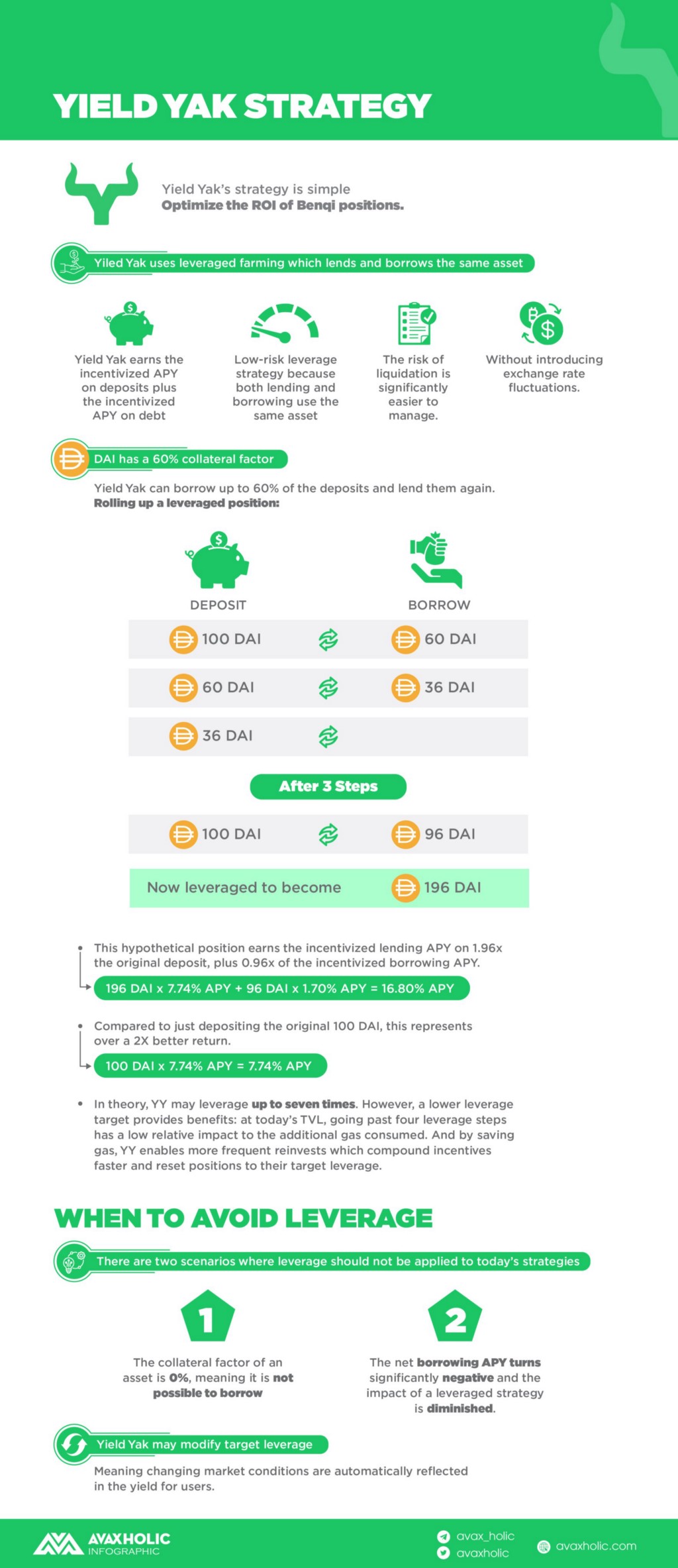
Other Autocompounders:
This can also be done on:
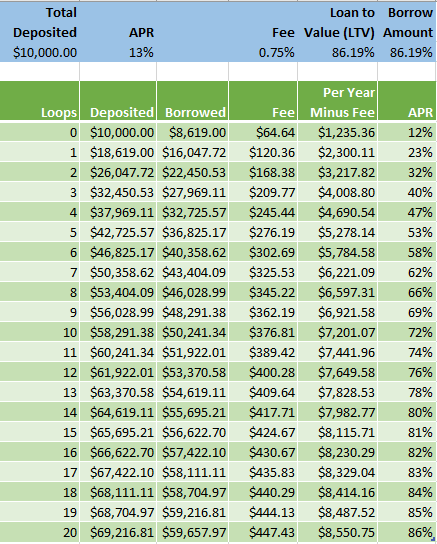
4. Stables
Not everyone likes dabbling in volatile assets, especially in down markets. Another option that allows you to take advantage of the high rewards on DeFi while staying relatively safe is stablecoins.
What is a Stablecoin?
We mention stablecoins in the section above. More precisely, a stablecoin is a token that pegs its value to an external asset. In most cases, stablecoins will peg their value to the United States Dollar (USD). The most well known stable coin is USDT (U.S. Dollar Tether) often just called Tether. For every fiat $USD Tether receives, it mints 1 USDT — therefore the peg remains 1:1.
This is a simplification as Tether does not always keep the exact number of dollars to USDT in their treasury, see “Risks with Stablecoins”.
What To Do with Stablecoins?
We mention above that stable assets generally have lesser rewards than a volatile asset, mainly because platforms want to incentivize people to hold the more volatile assets. That does not mean you cannot still earn spectacularly high rewards for your stables.
Best Things to Do with Stablecoins on Avalanche
There are several platforms and farms that offer great rewards for your stable assets:
Platypus Finance
Platypus is a stableswap (a platform for exchanging stable assets with minimal slippage) that offers an innovative way to earn high rewards on stables through “boosting”. Platypus is a relative newcomer to the Avalanche ecosystem but has hadDeFi strategy partially developed by Avalabs themselves.
You can participate on Platypus with 3 tokens:
- A stablecoin (either USDC.e, USDT.e or DAI.e)
- PTP — Platypus’ native token
- vePTP — Voting Escrow PTP
You deposit your stablecoin (as a liquidity provider) in one of the three stable pools. This will entitle you to a “base APR” on the platform which rewards you in $PTP. The base APR will usually be in the mid-single digits (i.e. 6%).

You can then boost the base APR by staking PTP on the platform. (To acquire PTP, you can swap for it on Trader Joe.) The boost you receive is correlated with the amount of vePTP you have. You get vePTP by staking PTP.
Here is how Platypus simplifies it:
- The Base Pool delivers rewards solely based on the stablecoin deposits.
- The Boosting Pool requires depositors to stake PTP and delivers rewards based on both staked PTP and stablecoin deposits.

5. Avalanche NFTs
You may be most familiar with NFTs on Ethereum (Bored Apes, Cryptopunks, Cool Cats) but Avalanche also has a robust NFT ecosystem (including yours truly)
How to Get Started with NFTs on Avalanche?
The NFT ecosystem is similar in terms of types of projects to Ethereum and Solana but with some key advantages:
- Gas fees: the low cost to transact on Avalanche extends to NFTs. Purchasing an NFT on Avalanche generally only costs a few cents (not including the price of the NFT itself)
- NFT Costs: The Avalanche ecosystem is newer and costs are not as high compared to Ethereum (not even including gas). Whereas a PFP (profile picture) project on Ethereum may have a mint price of 0.05 to 0.1 ETH (~$175 to $350 + gas fees), Avalanche projects generally cost between $75 to $150 + (negligible) gas fees
- More utility: The DeFi aspect of Avalanche is usually present in NFT projects, adding another dimension not seen as often on Ethereum
How to Find Projects:
The best way to find projects, old and new, on Avalanche is on Twitter. Every project has a presence there. Since the space is smaller, most projects are supported by members within the Avalanche community.
There are also several communities dedicated to highlighting and showing off the best NFT projects on Avalanche. We would recommend following:
Notable Avalanche NFT Projects
Since the Avalanche NFT ecosystem is much younger than the Ethereum one, it’s difficult to say what is a true “blue chip” NFT like Bored Ape Yacht Club or Cryptopunks. Here are some of the most popular however based on marketcap and number of collectors.
10,000 randomly generated apes. Minters received a reflection of all minting fees.

10,000 randomly generated mascots of Avalanche (“Wolfie”)

10,000 out of this world Chickens. Comes with a highly popular gaming element (more on GameFi later)

The 1st major NFT project to release on Avalanche.

Lost Worlds NFT
How could we not mention ourselves?
Lost Worlds brings NFT into the real world, allowing you to mint at some of the worlds greatest landmarks. We are releasing soon!

Disclaimer: There are many projects that deserve recognition but can’t fit on here. We encourage you to find more projects here: https://avaxnftstats.com/
NFT Marketplaces on Avalanche
Avalanche has a few different NFT marketplaces. None are quite as dominant and well known as Opensea is to Ethereum, but they are growing alongside the Avalanche NFT ecosystem. The main marketplaces include:
How to Get Started as an NFT Artist in Avalanche
The Avalanche NFT community is highly supportive and a great entry point for a new NFT artist. Some of the best ways to get started is:
- Mint a collection on Kalao or NFTrade
- Create a Twitter account (make sure you remember to include the red triangle in your handle!)
- Start a Discord to form a community around your work
- Participate in Twitter Spaces to talk about your project
- Reach out to Avax Club Degen or Avax NFT to talk about your project
- Support other projects and artists either through promoting them on your social accounts or buying their art
Minting on Kalao
Kalao makes it easy to mint your art and create a collection. Say for example your entire thing is fine art cat photos. You can go to Kalao, click on the “create” tab at the top and you’ll get the following prompt.
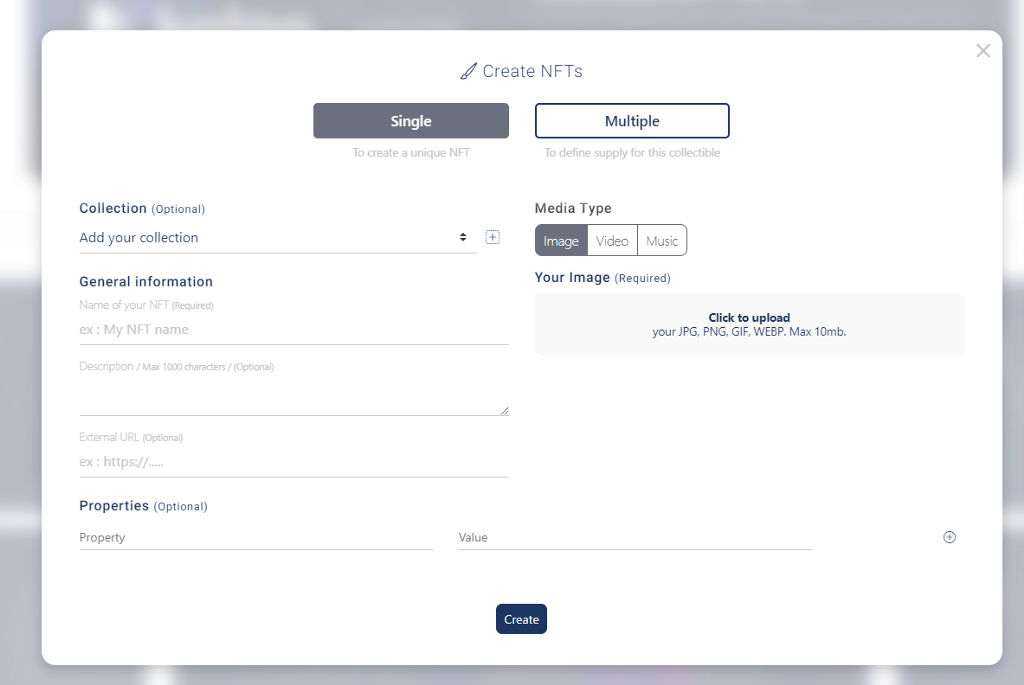
You’ll notice there are several inputs:
- Collection: the name of the set. In this case “AVAX Cat Photos”
- General Info: a description
- Properties: This is the metadata of the art that is minted onto the blockchain. In this case “Cat Type: Taby Cat” can be a property. Properties can determine how rare an individual NFT is relative to the collection.
- Media Type: In this case we are using images, but you can mint videos and music files as well.
Once you click create, you’ll be asked to pay for the gas fees ( a few cents). Compared to Ethereum, you may end up spending several hundred dollars just on gas fees putting up your art on Opensea.

6. GameFi on Avalanche
GameFi (Gaming + Finance) combines three essential things, gaming, DeFi and NFTs. The speed and low cost of Avalanche makes it possible to develop games on top of the DeFi mechanics that drive the value of the protocol. In traditional games, players generally do not earn real world currency. GameFi is changing that and rewarding players with real world money.
How Does GameFi Work?
There are numerous mechanics and different types of games built on blockchains. It is difficult to sum it up in one way how gamefi “works”. There are some popular styles of gaming however.
Collecting, Breeding, Battling — Crabada
Have you ever played Pokemon? Have you ever wished you could sell some of the rare Pokemon you bred or trained? The traditional Nintendo games are fun, but do not let you earn anything for the hours of hard work you put in.

Crabada, built exclusively on Avalanche, is changing that. There aren’t a variety of species like with Pokemon (the game focuses exclusively on crabs) but you will find some overlaps. On Crabada you can:
- Breed Crabs
- Form a team and battle other teams of Crabs
- Go on missions with your crab teams
The difference is that each crab you own is an NFT. So if you breed a crab, you own that crab and can sell that crab to someone else. You can use your crabs to battle other teams and earn rewards in $TUS (Crabada’s currency).
How to Get Started with Crabada
The downside to Crabada is the cost to start is a bit high. As of writing, one crab costs ~$3,000 USD meaning to form a team of 3 (the number necessary for battles) would cost at minimum $9,000 or roughly 90ish AVAX.
If you can afford a team, it is simple to buy the crabs off of the Crabada marketplace: https://marketplace.crabada.com/
RPG Gaming — DeFi Kingdoms
DeFi Kingdoms combines all the mechanics of DeFi (staking, swapping, NFTs) with the feel of a RPG. You can purchase hero NFTs and go on quests. You can also do normal DeFi actions like we discuss above (staking, liquidity providing) in the context of the game. You can learn more here.
DeFi kingdoms is not yet on Avalanche, but will be soon. The game currently lives on Harmony (another blockchain) but has nearly $1 Billion USD locked up in the game.
You can provide liquidity to the $JEWEL (the DeFi kingdom currency) — AVAX pool to be eligible for an airdrop of the Avalanche version of DeFi Kingdom’s currency when it is launched.
Launching on Avalanche will likely open up new features to the game, so stay tuned on how to get started on DeFi Kingdoms on Avalanche from the start.
Passive Income — Chikn
Remember Chikn above? That NFT can end up earning you a hefty chunk of change per day in a highly passive manner. If you own a Chikn NFT, you may “roost” that Chikn. Once that Chikn is roosted, you can give it $Feed to increase the size of the Chikn. You get $feed by staking your $egg. The larger the Chikn, the more $EGG, the game’s token, you earn. The more $egg, the more $feed, the bigger the Chikn.
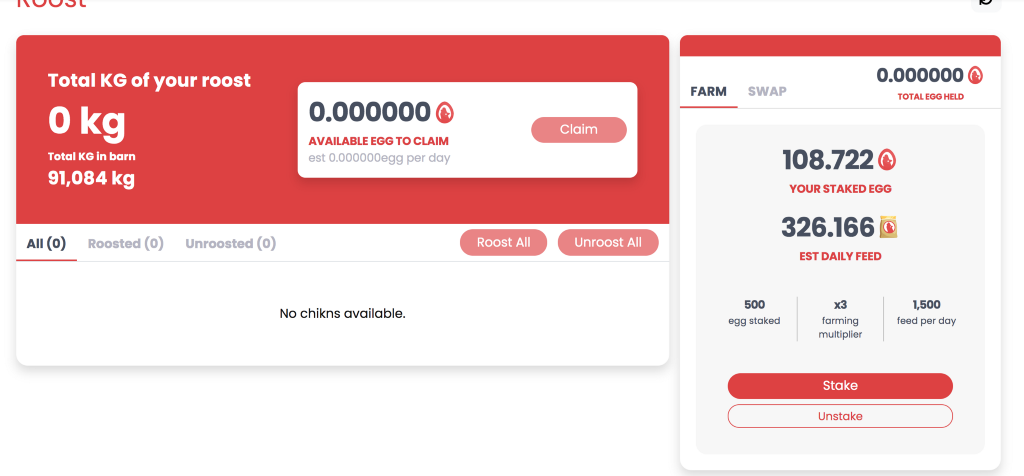
For example, you can purchase a 4Kg Chikn for ~20 AVAX. That Chikn will then give you ~2 to ~4 $EGG per day. As of writing, 1 $EGG is worth about $6 USD, meaning you can earn about $12 to $48 per day for a relatively small Chikn.
AAA Gaming — Imperium Empires
Imperium Empires is an upcoming AAA game launching on Avalanche. It has high level graphics like those you would see on a console or PC game. More details of the game are being released.

7. Build an Avalanche dApp (decentralized app)
Everything we’ve discussed so far is how to use the Avalanche ecosystem, but you can also build and contribute to the Avalanche ecosystem. To build on Avalanche, you’ll need to be familiar with
- Javascript
- Web Development
- Solidity
Even if you aren’t an expert in those things, there are many resources to learn. If you are ready to build a dApp, these are the steps to start:
- Download and run an Avalanche node on your local machine
- Requirements: AvalancheGo
2. Build a smart contract and deploy it to the local, and test networks
- Requirements: Solidity, Hardhat3
3. Build a frontend to interact with smart contract
- Requirements: React, Next.js, Ethers.js, Metamask
4. Hosting the application
- Requirements: Vercel
To learn about the full process for developing your dApp, read more here. Avalanche itself also has some very helpful docs: https://docs.avax.network/build/tutorials/platform/launch-your-ethereum-dapp/
Out of the Box Solutions
There are also some companies who can accelerate your dApp creation and get you up and running in a few short minutes. We recommend looking at:
Both allow you to build a dApp on Avalanche.
Helpful Tools and Resources
There are several tools and resources that can make your crypto journey on Avalanche much easier to manage. Here are some of those resources:
Zapper.Fi: you may be overwhelmed by depositing your tokens across all of these different platforms. Zapper.Fi integrates with your wallet and lays out where all your tokens are dispersed. It shows you your debt, assets and total crypto networth (not including what is on a centralized exchange)

Snowtrace: Snowtrace is the C-chain explorer for the AVAX ecosystem .The nice thing about the blockchain is you can see every transaction happening on it. There are times where it’s helpful to see whether a transaction you made actually went through or to see what contract you are engaging with. Simply put your wallet address on Snowtrace to see your wallet and transactions.

Notable People to Follow on Twitter
You end up learning the most about the Avalanche ecosystem by following those who have an active hand in shaping or reporting on it. Here are some of the best people to follow on Twitter to keep up to date with Avalanche:
Ava Labs (Avalanche development team)
- Emin Gun Sirer: Founder of the whole project
- Kevin Sekniqi: Chief Protocol Architect
- Luigi D’Onorio DeMeo: Head of DeFi, masterminding new frontiers for DeFi
- Farid Rached: Ecosystem Growth, knows all the upcoming projects
- Jay Kurahashi-Sofue: VP of Marketing, summarizes all the developments happening
- Gabriel Cardona: Developer evangelist
- Connor Daly: Developer and builder
Avalanche Veterans/Builders/Creators/Influencers:
Avalanche Memes and the Culture
Being part of the Avalance ecosystems means being part of the budding culture. There are numerous memes, characters, personalities and sayings to familiarize yourself with.
- GM: “good morning”. Posting GM is crypto etiquette (not just Avalanche)
- GB: “good bridging”. A term that riffs off of GM and started when Avalanche debuted the Avalanche bridge
- WGMI: “We’re gonna make it” — in crypto the ultimate goal is to make it, whatever that means to you (not just Avalanche)
- NGMI: “not gonna make it” — reserved for the doubters and right click savers (not just Avalanche)
- “Can Devs do something” — a common meme saying on Avalanche when things aren’t going well. Shout out to Hard Rock Nick!
- Wolfie: the unofficial mascot of Avalanche
- Red Coin Gud: Avalanche is the red coin, and its a solid project
Final Thoughts
Avalanche is still a young but very exciting blockchain ecosystem. The saying goes “we’re still early” and as of early-2022, if you are entering the Avalanche ecosystem, you are early.
As a beginner, Avalanche will give you the most freedom and leeway to experiment and try different strategies without having to worry about wasting money on expensive gas fees.
The diverse nature of projects being built on Avalanche, from strict DeFi, to innovative DeFi, NFTs, games — there will always be something for everyone.
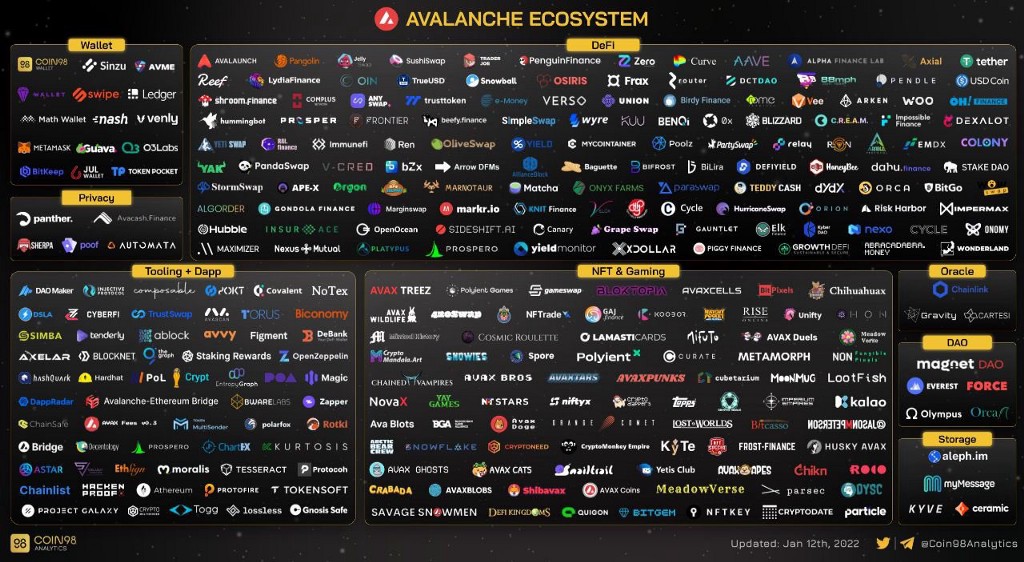
Are We Missing Something?
We tried to be as inclusive and broad as possible when putting together this guide. We want to provide the most seamless onboarding experience for any newcomer to Avalanche. That being said, the space grows every day and there may be some core projects that we miss today but are or will be essential in just a short amount of time. If you feel we’re missing you or your project, DM us at @lostworldsnft on Twitter or email universe@lostworlds.io.


